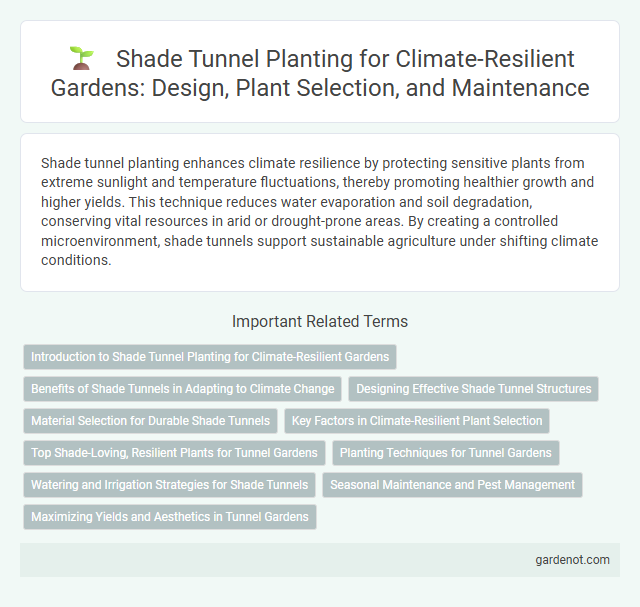Shade tunnel planting enhances climate resilience by protecting sensitive plants from extreme sunlight and temperature fluctuations, thereby promoting healthier growth and higher yields. This technique reduces water evaporation and soil degradation, conserving vital resources in arid or drought-prone areas. By creating a controlled microenvironment, shade tunnels support sustainable agriculture under shifting climate conditions.
Introduction to Shade Tunnel Planting for Climate-Resilient Gardens
Shade tunnel planting enhances climate resilience by providing controlled microclimates that reduce heat stress and water loss in gardens. Utilizing shade netting materials with varying density, these tunnels protect delicate plants from excessive sunlight and extreme weather, promoting healthier growth. This technique supports sustainable gardening by conserving soil moisture and enabling cultivation in hotter, drier environments.
Benefits of Shade Tunnels in Adapting to Climate Change
Shade tunnels enhance crop resilience by moderating temperature extremes and reducing direct solar radiation, which mitigates heat stress and water loss in plants. These structures improve microclimate conditions, promoting higher yields and extended growing seasons even under fluctuating climate scenarios. Shade tunnels also reduce pest incidence and soil erosion, supporting sustainable agriculture and adapting effectively to climate variability.
Designing Effective Shade Tunnel Structures
Designing effective shade tunnel structures involves selecting durable, UV-resistant materials that balance light diffusion and temperature control to optimize plant growth. Proper orientation and ventilation within the tunnel enhance airflow, reducing heat stress and humidity build-up for climate-resilient crops. Integrating adjustable shading mechanisms further adapts plants to varying climatic conditions, improving yield stability under environmental fluctuations.
Material Selection for Durable Shade Tunnels
Material selection for durable shade tunnels is critical in climate-resilient planting, emphasizing UV-resistant polyethylene or high-density polypropylene fabrics that withstand prolonged sun exposure and heavy rainfall. Using galvanized steel or aluminum frames enhances structural integrity against strong winds and corrosion, ensuring longevity. Incorporating breathable, tear-resistant materials improves microclimate control while reducing maintenance costs in diverse environmental conditions.
Key Factors in Climate-Resilient Plant Selection
Shade tunnel planting enhances microclimate control, crucial for climate-resilient crop selection by reducing heat stress and conserving moisture. Key factors include choosing plant varieties with high tolerance to temperature extremes, pests, and diseases, alongside efficient water-use capabilities. Integrating shade tunnels with drought-resistant and fast-maturing crops optimizes yield stability under variable climatic conditions.
Top Shade-Loving, Resilient Plants for Tunnel Gardens
Top shade-loving, resilient plants ideal for shade tunnel planting include ferns, hostas, and caladiums, which thrive under controlled light and moisture conditions. These species demonstrate exceptional tolerance to low light and fluctuating temperatures, making them perfect for climate-resilient tunnel gardens. Incorporating such plants enhances microclimate stability and promotes sustainable urban agriculture.
Planting Techniques for Tunnel Gardens
Shade tunnel planting employs specific techniques to optimize microclimate control, such as spacing plants to maximize airflow while reducing heat stress. Using materials like polyethylene or mesh fabrics, these tunnels regulate sunlight intensity and humidity, promoting resilient growth in extreme weather. Proper irrigation methods and soil preparation enhance water retention and nutrient availability, ensuring sustainable plant development within tunnel gardens.
Watering and Irrigation Strategies for Shade Tunnels
Effective watering and irrigation strategies for shade tunnels involve precise moisture management to prevent water stress and optimize plant growth under reduced sunlight. Drip irrigation systems are highly recommended for delivering consistent, targeted water supply, minimizing evaporation and runoff in shaded environments. Incorporating soil moisture sensors aids in monitoring hydration levels, ensuring timely irrigation that conserves water while maintaining ideal conditions for climate-resilient crops.
Seasonal Maintenance and Pest Management
Shade tunnel planting requires seasonal maintenance such as regular pruning, irrigation adjustments, and cleaning to optimize light penetration and airflow, promoting healthy crop growth. Pest management involves integrated strategies like biological control agents, targeted pesticide application, and monitoring pest populations to prevent infestations and reduce chemical use. Effective maintenance and pest management in shade tunnels enhance crop resilience to climate variability and improve yield stability.
Maximizing Yields and Aesthetics in Tunnel Gardens
Shade tunnel planting enhances microclimate control, reducing heat stress and water loss to maximize crop yields in tunnel gardens. Strategic use of shade cloth materials with optimal light diffusion improves plant growth and vibrant aesthetics by preventing sunburn and promoting uniform development. Integrating adjustable shading systems allows precise management of light intensity, supporting both productivity and visual appeal throughout the growing cycle.
Shade tunnel planting Infographic

 gardenot.com
gardenot.com